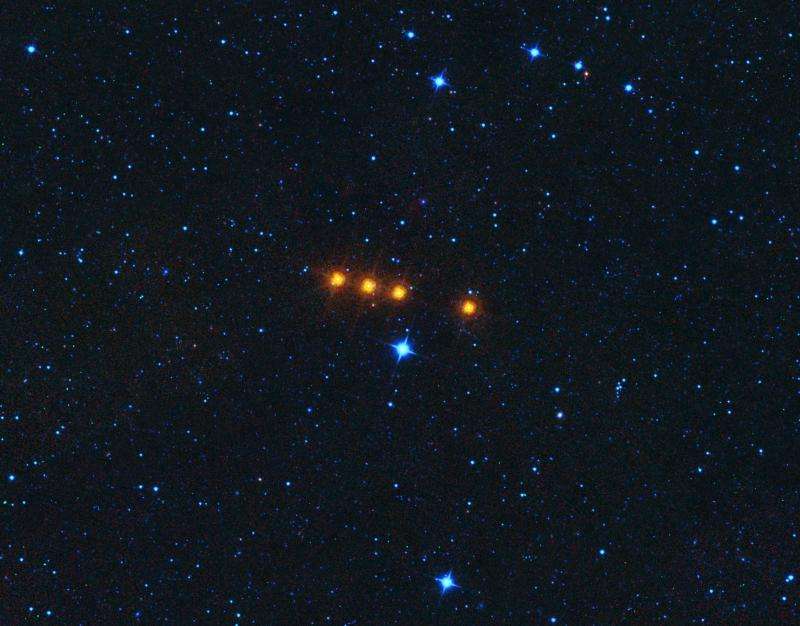Tracking a mysterious group of asteroid outcasts

High above the plane of our solar system, near the asteroid-rich abyss between Mars and Jupiter, scientists have found a unique family of space rocks. These interplanetary oddballs are the Euphrosyne (pronounced you-FROH-seh-nee) asteroids, and by any measure they have been distant, dark and mysterious—until now.
Distributed at the outer edge of the asteroid belt, the Euphrosynes have an unusual orbital path that juts well above the ecliptic, the equator of the solar system. The asteroid after which they are named, Euphrosyne—for an ancient Greek goddess of mirth—is about 156 miles (260 kilometers) across and is one of the 10 largest asteroids in the main belt. Current-day Euphrosyne is thought to be a remnant of a massive collision about 700 million years ago that formed the family of smaller asteroids bearing its name. Scientists think this event was one of the last great collisions in the solar system.
A new study conducted by scientists at NASA's Jet Propulsion Laboratory in Pasadena, California, used the agency's orbiting Near-Earth Object Wide-field Infrared Survey Explorer (NEOWISE) telescope to look at these unusual asteroids to learn more about Near Earth Objects, or NEOs, and their potential threat to Earth.
NEOs are bodies whose orbits around the sun approach the orbit of Earth; this population is short-lived on astronomical timescales and is fed by other reservoirs of bodies in our solar system. As they orbit the sun, NEOs can occasionally have close approaches to Earth. For this reason alone—the safety of our home planet—the study of such objects is important.
As a result of their study, the JPL researchers believe the Euphrosynes may be the source of some of the dark NEOs found to be on long, highly inclined orbits. They found that, through gravitational interactions with Saturn, Euphrosyne asteroids can evolve into NEOs over timescales of millions of years.
NEOs can originate in either the asteroid belt or the more distant outer reaches of the solar system. Those from the asteroid belt are thought to evolve toward Earth's orbit through collisions and the gravitational influence of the planets. Originating well above the ecliptic and near the far edge of the asteroid belt, the forces that shape their trajectories toward Earth are far more moderate.
"The Euphrosynes have a gentle resonance with the orbit of Saturn that slowly moves these objects, eventually turning some of them into NEOs," said Joseph Masiero, JPL's lead scientist on the Euphrosynes study. "This particular gravitational resonance tends to push some of the larger fragments of the Euphrosyne family into near-Earth space."
By studying the Euphrosyne family asteroids with NEOWISE, JPL scientists have been able to measure their sizes and the amount of solar energy they reflect. Since NEOWISE operates in the infrared portion of the spectrum, it detects heat. Therefore, it can see dark objects far better than telescopes operating at visible wavelengths, which sense reflected sunlight. Its heat-sensing capability also allows it to measure sizes more accurately.
The 1,400 Euphrosyne asteroids studied by Masiero and his colleagues turned out to be large and dark, with highly inclined and elliptical orbits. These traits make them good candidates for the source of some of the dark NEOs the NEOWISE telescope detects and discovers, particularly those that also have highly inclined orbits.
NEOWISE was originally launched as an astrophysics mission in 2009 as the Wide-field Infrared Survey Explorer, or WISE. It operated until 2011 and was then shut down. But the spacecraft, now dubbed NEOWISE, would get a second life. "NEOWISE is a great tool for searching for near-Earth asteroids, particularly high-inclination, dark objects," Masiero said.
There are over 700,000 asteroidal bodies currently known in the main belt that range in size from large boulders to about 60 percent of the diameter of Earth's moon, with many yet to be discovered. This makes finding the specific point of origin of most NEOs extremely difficult.
With the Euphrosynes it's different. "Most near-Earth objects come from a number of sources in the inner region of the main belt, and they are quickly mixed around," Masiero said. "But with objects coming from this family, in such a unique region, we are able to draw a likely path for some of the unusual, dark NEOs we find back to the collision in which they were born."
A better understanding of the origins and behaviors of these mysterious objects will give researchers a clearer picture of asteroids in general, and in particular the NEOs that skirt our home planet's neighborhood. Such studies are important, and potentially critical, to the future of humanity, which is a primary reason JPL and its partners continue to relentlessly track these wanderers within our solar system. To date, U.S. assets have discovered more than 98 percent of the known NEOs.
Provided by NASA





















